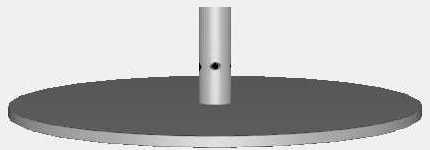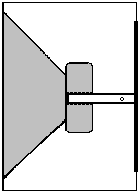

Posted by Wayne Parham [ 67.67.29.151 ] on June 30, 2005 at 12:59:36:
In Reply to: Re: Speaker Voice Coil Cooling System - Heat Sink posted by Wayne Parham on June 29, 2005 at 13:28:09:
Since the motor core becomes extremely hot from induction and radiation, one could sink the heat into a device like that shown below.

It's a simple device, just two parts.
One part is a large aluminum panel that attaches to the cabinet. If the system is a basshorn, this can double as the access panel. It is just a large sheet of aluminum, thick enough to prevent vibration or panel flex, since it will be used as part of the loudspeaker cabinet. Grooves may be cut in its surface to increase surface area. That's the key, because it will function as a heat exchanger, as a radiator of heat.
The second part is an aluminum rod, of diameter that fits snugly in the speaker vent hole. On one end, it is drilled with a threaded hole to accept a bolt, so it can be attached to the radiating panel. On the other end, it is drilled with a larger diameter hole, to act as the duct for cooling air. Holes are also cross-drilled along its shaft so that cooling vent air can pass through it.

The duct should fit snugly. When completely inserted, the internal end should be approximately flush with the front pole piece. That way the aluminum tube touches as much of the pole piece as possible, for most effective heat transfer. But it is not longer, so that it doesn't interfere with the cone or dust cap at high excursion.
These parts are simple and can be machined at any competent machine shop. Assembly is straight-forward. Put some heat-sinking compound on the open end of the tube and slide it into the speaker magnet vent. Use the same compound that is used on power transistors when mounting on a heat sink. Put some heat sink compound on the threaded end of the tube also, and attach it to the radiating panel with a bolt. Tighten the panel down and you're done.

This kind of system can be used on basshorns with access panels near the speaker magnet. It can also be used in standard direct-radiating cabinets, by making a version with a longer rod that reaches from the cabinet to the magnet.
Speakers with exposed magnets, such as dipoles, isobaric and push-pull configurations may benefit from ducted arrangements since they serve to muffle vent noises in addition to assiting in cooling. But if the magnet isn't exposed, then this simple heat sink radiator might be more attractive.
[ PiSpeakers Forum ] [ Help ]